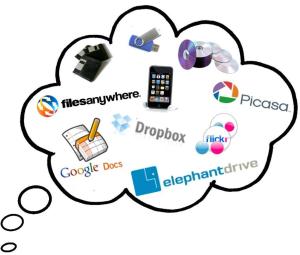 In just a handful of decades, technology has come a long way in terms of computing storage. There were the punch cards in the 1960s, cassette tapes in the 1970s, floppy disks in the 1980s, CD-R and RW discs in the 1990s, and the 2000s saw the advent of thumb drives and SD cards.
In just a handful of decades, technology has come a long way in terms of computing storage. There were the punch cards in the 1960s, cassette tapes in the 1970s, floppy disks in the 1980s, CD-R and RW discs in the 1990s, and the 2000s saw the advent of thumb drives and SD cards.Today, there are a number of storage options are available for students on most campuses, including jump drives, CD-R & RW, DVD-R and file space on campus servers. Your ipod can also be used just like a thumb drive, provided you haven’t packed it to it’s limit with music… And don’t forget that you can store your files in the “cloud.” For instance, many colleges have obtained Google Enterprise accounts and offer students free accounts. Using such an account, you can create an unlimited number of google documents, presentations and spreadsheets. Additionally, you can upload up to 1 GB of word, pdf, and power point, and excel files to your google docs account. Once you do so, you can access them from any computer with internet access.
There are a number of other online storage services for which you can take advantage, most of which offer 1 or 2 GB of free storage. Dropbox is an online storage service that allows you to store/share up to 2GB of files. You have to install a small program on your computer to run it, but it allows you to upload any type of file as long as it is under 350MB. Similar services include ElephantDrive (2GB free), FilesAnywhere (1 GB free), and FlipDrive (1 GB free) to name a few. (LiveMesh is a similar service that allows you to store up to 5GB for free, but only works for PC users running Vista or Windows 7).
For storing photos and videos, there are a number of options available. Google’s Picasa Web Album is accessible through your Geneseo Google Apps account. Picasa allows you to store (and share if you wish) up to 1 GB of video and photo files. An alternative to Picasa is Flickr, which allows you to upload up to 300 MB of photos and 2 videos per month.
Do you have a favorite storage/sharing service not mentioned above? Leave a comment below to let me know about it!


